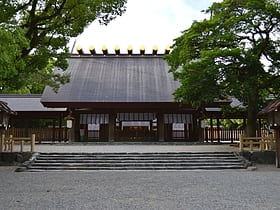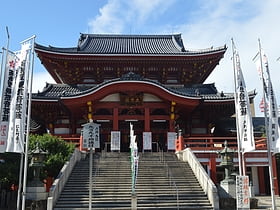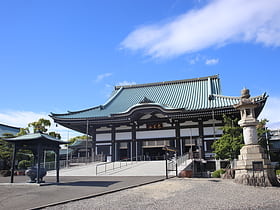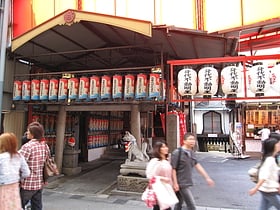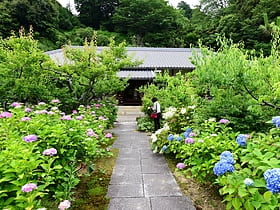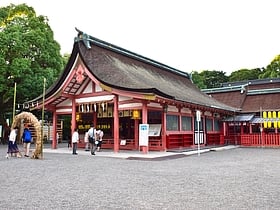Nagoya: Temple
Places and attractions in the Temple category
Categories
- Museum
- Temple
- Area
- Park
- Sacred and religious sites
- Art museum
- City
- Buddhist architecture
- Specialty museum
- Universities and schools
- Forts and castles
- Archaeological site
- Theater
- Concerts and shows
- Nightlife
- Event space
- History museum
- Concert hall
- Art gallery
- Sport
- Sport venue
- Town
- Neighbourhood
- Arenas and stadiums
Atsuta Shrine
Atsuta Shrine, nestled in the bustling city of Nagoya, Japan, is a beacon of tranquility and spiritual reverence. This ancient Shinto shrine, believed to have been established during the first century, is one of the most significant places of worship in the country.
Ōsu Kannon
Nestled in the bustling heart of Nagoya, Japan, Ōsu Kannon stands as a serene escape and a beacon of cultural heritage. This historic Buddhist temple, dedicated to the goddess of mercy, Kannon, is a cherished site that has welcomed worshippers and tourists alike for...
Nittai-ji
Nittai-ji Temple stands as a serene symbol of peace and friendship between Japan and Thailand in the bustling city of Nagoya. This historically significant temple, established in 1904, is unique in that it is not affiliated with any particular Buddhist sect.
Banshō-ji
Banshō-ji, a serene temple nestled in the bustling heart of Nagoya, Japan, offers a tranquil escape from the city's relentless pace. This historic site, originally founded in 1532 by Oda Nobuyasu, the uncle of the famed warlord Oda Nobunaga, has long been a bastion of...
Honkō-ji
Honkō-ji, a serene Buddhist temple located in the bustling city of Nagoya, Japan, stands as a spiritual oasis amid urban life. This historic temple, belonging to the Nichiren sect, dates back to the Edo period, offering a glimpse into the religious and cultural...
Kenchū-ji
Kenchū-ji is a Jōdo-shū Buddhist temple in Tsutsui, Higashi-ku, Nagoya, central Japan. Starting in the Edo period, the mausoleums of the lords of the Owari Domain were located there, making it the Bodaiji of the Owari Tokugawa family.
Arako Kannon
Arako Kannon, also known as Jōkai-san Enryū-in Kannon-ji is a Buddhist temple located in Nagoya in central Japan. It has a wooden pagoda which is one of Japan's oldest, dating to the 16th century. Maeda Toshiie's family bodhisattva.
Seigan-ji
Seigan-ji is a Buddhist temple located in Atsuta-ku, Nagoya, in central Japan. It is located on Fushimi-dōri, one of the main avenues of the city.
Tsushima Shrine
Tsushima Shrine is a Shinto shrine in Tsushima, Aichi Prefecture, Japan. It is the head shrine of a nation-wide shrine network of shrines dedicated to the Tsushima Cult, Centered primarily in the Tōkai region, this network has approximately 3,000 shrines, and is the tenth-largest network in the country.
Kawahara Shrine
The Kawahara Shrine is a Shinto shrine and Buddhist Benten-dō located in the Showa ward of Nagoya, central Japan. The construction date of the shrine is not clear, it is assumed however that is appeared around 1000.
Kōshō-ji
Kōshō-ji is a Shingon Buddhist temple located in Yagoto, Nagoya, in central Japan. It belongs to the Owari Thirty-three Kannon.
Toyokuni Shrine
Toyokuni Shrine is a Shinto shrine located in Nakamura-cho, Nakamura-ku, Nagoya, central Japan. It was built to commemorate Toyotomi Hideyoshi, who hailed from the region.
Gokiso Hachimangū
Gokiso Hachiman-gū is a Shinto shrine located in the city of Nagoya, central Japan.
Fuji Sengen Shrine
The Fuji Sengen Shrine is a Shinto shrine located in Ōsu in central Nagoya, central Japan.
Shōman-ji
Shōman-ji is a Buddhist temple in Naka-ku, Nagoya, central Japan.
Kōjaku-in
Kōjaku-in is a Buddhist temple in Kawanayama-chō, Shōwa-ku, Nagoya, Aichi prefecture in central Japan. The temple is associated with the production of Kawana ware during the Edo period.
Tōgan-ji
Tōgan-ji is a Buddhist temple of the Sōtō Zen sect located in Nagoya, central Japan.
Nagoya Shrine
The Nagoya Shrine is a Shinto shrine located in Marunouchi in the Naka Ward in Nagoya, central Japan.
Shiroyama Hachimangū
Shiroyama Hachimangū, also known as Shiroyama Hakusan, is a Shinto shrine located in the city of Nagoya, central Japan.
Hongan-ji Nagoya Betsuin
The Hongan-ji Nagoya Betsuin is a Jōdo Shinshū Buddhist temple located in Naka ward, Nagoya in central Japan. The temple is a short distance south of Ōsu Kannon Station. It is also known a Nishi Betsuin, being associated with Nishi Hongan-ji.
Aichi Prefecture Gokoku Shrine
The Aichi Prefecture Gokoku Shrine is a Shinto shrine located in the Sannomaru enceinte, next to Nagoya Castle, in central Nagoya, Japan.
Tsukiji Shrine
Tsukiji Shrine is a Shinto shrine in Minato-ku, Nagoya, Aichi Prefecture, Japan.
Kasadera Kannon
Kasadera Kannon, also known as Ryūfuku-ji is a Buddhist temple located in Minami-ku, Nagoya in central Japan. It is a part of the Owari Thirty-three Kannon.
Yamada Tenman-gū
Yamada Tenman-gū is a Shinto shrine located in Nagoya, central Japan. The deity of this shrine is Sugawara no Michizane. According to legend, the shrine was constructed in 1672 as a guardian to Nagoya Castle and as place to pray for academic wishes in the Owari Province. In 1983, the Kogane shrine was merged into this shrine.
Nagoya Tōshō-gū
Nagoya Tōshō-gū is a Shinto shrine located in central Nagoya, Aichi Prefecture, Japan.
Miao xing si
Myogyouji Temple is a Nichiren Shu temple located in Nakamura-cho, Nakamura-ku, Nagoya City, Aichi Prefecture. Its mountain name is Shoetsuzan. The main deity is the Lotus Sambhogakaya.
Zong jian si
Soumi-ji Temple is a temple of the Myoshinji School of Rinzai Zen Buddhism located in Naka-ku, Nagoya City, Aichi Prefecture, Japan. The name of the temple is Keiyozan. The temple is associated with Nobunaga Oda.
Cheng tian shan wan fu yuan
Manpukuin Temple is a Buddhist temple of the Chizan School of Shingon Buddhism located in Sakae 5-chome, Naka-ku, Nagoya City, Aichi Prefecture. It is a branch temple of Naritasan Shinshoji Temple and enshrines Fukurokuju, one of the seven gods ...
Map

